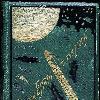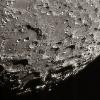

Tags: From The Earth To The Moon View |
have diameters ranging from 300 to 1 200 km The largest similar in extent to western Europe measures more than 2 500 km across and possibly all of them date to the period 4 0 3 8 Ga Conventional cosmology pictures the solar system as forming from a nebula of dust and gas in a process where some of the aggregating bodies reached planet size and others did not Embryonic Tags: From The Earth To The Moon View |
1280x1024 1024x768 800x600 Tags: From The Earth To The Moon View |
|||||||||
From the Earth to the Moon (lang-frDe la Terre � la Lune, 1865 (1865 in literature)) is a humorous science fantasy novel by Jules Verne and is one of the earliest entries in that genre. It tells the story of the president of a post-American Civil War gun club in Baltimore, his rival, a Philadelphia maker of armor, and a Frenchman (French people), who build an enormous sky-facing Columbiad (Columbiad#In_fiction) space gun and launch themselves in a projectile/spaceship from it to a Moon landing.
The story is also notable in that Verne attempted to do some rough calculations as to the requirements for the cannon and, considering the total lack of any data on the subject at the time, some of his figures are surprisingly close to reality. However, his scenario turned out to be impractical for safe manned space travel since a much longer muzzle (Muzzle (firearm)) would have been required to reach escape velocity while limiting acceleration to survivable limits for the passengers.
The real-life Apollo program bears similarities to the story: *Vernes cannon was called Columbiad; the Apollo 11 command module (Apollo CSM) was named Columbia. *The spacecraft crew consisted of three persons in each case. *The physical dimensions of the projectile are very close to the dimensions of the Apollo CSM. *Vernes voyage blasted off from Florida, as did all Apollo missions. (Verne correctly states in the book that objects launch into space most easily if they are launched towards the zenith of a particular location, and that the zenith would better line up with the moons orbit from near the Earths equator. In the book Florida and Texas compete for the launch, with Florida winning.) *The names of the crew, Ardan, Barbicane, and Nicholl, are vaguely similar to Bill Anders, Frank Borman, and Jim Lovell, the crew of Apollo 8, the first manned spacecraft to travel to the moon, although it didnt actually land. *The cost of the program in the book is almost similar to the total cost of the Apollo program until Apollo 8.
The character of "Michel Ardan" in the novel was inspired by F�lix Nadar (Nadar (photographer)).
Title Orig: De la Terre � la Lune
Translator: Lewis Page Mercieer; T.H. Linklate; Edward Roth; anonymous
Translator: unknown (1867), J.K. Hoyt (1869), Louis Mercier (Lewis Page Mercier) & Eleanor E. King (Eleanor Elizabeth King) (1873); Edward Roth (1874); Thomas H. Linklater (1877); I. O. Evans (Idrisyn Oliver Evans) (1959), Lowell Bair (1967), Jacqueline (Jacqueline Baldick) and Robert Baldick (1970), Harold Salemson (1970), Walter James Miller (1996)
Author: Jules Verne
Illustrator: Henri de Montaut
Language: French (French language)
Series: The Extraordinary Voyages (Voyages Extraordinaires) #4
Genre: Science fiction novel
Publisher: Pierre-Jules Hetzel
Release Date: 1865
English Pub Date: 1867
Media Type: Print (Hardback (Hardcover))
Isbn: N/A
Preceded By: A Journey to the Center of the Earth
Followed By: In Search of the Castaways The projectile, as pictured in an engraving from the 1872 Illustrated Edition. (Image:FETMprojectile.jpgthumbrightupright) Image:FETMlaunch.jpgthumbrightuprightThe firing of the Columbiad (Columbiad#In_fiction).



